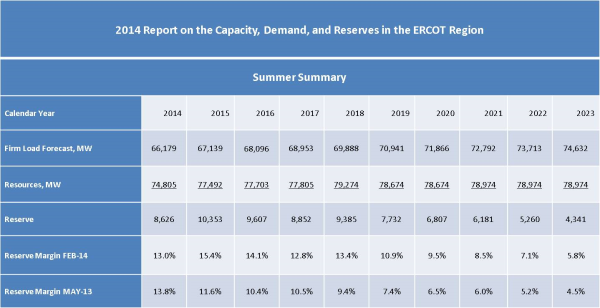On Friday, February 28, ERCOT published its 2014 Capacity, Demand and Reserves (CDR) report. Resource adequacy has been at the forefront of ERCOT’s electricity policy debate. Forecasting future demand is critical for planning purposes to determine how much generation will be needed in future years to meet peak demand. Resource adequacy concerns have prompted the PUCT to approve mechanisms that increase the duration and frequency of scarcity pricing signals in ERCOT to support adequate generation development in the state. One measure, that has also encouraged some Commercial and Industrial customers to take advantage of higher prices through prices response (load shedding and Distributed Generation (DG) dispatch), is the October 2012 decision to increase the system-wide offer cap to the following levels, effective on the dates below:
ERCOT's Latest CDR Report Shows Higher Reserve Margins: How Will This Affect Regulatory Policy?
Posted by Jennifer Chang on Mar 5, 2014 10:15:00 AM
Topics: ERCOT, risk management, Energy Solutions, energy procurement, demand response, energy reliability, power generation, Weekly Energy Insights, reserve margin, energy price spikes, energy blog, reserve, report, energy efficiency, U.S. energy, PUCT, forecasting, CDR, capacity, demand, load shedding, distributed generation, scarcity pricing, current outlook
ERCOT Revamping Power Forecasting Methodologies: Reserve Margin Challenges
Posted by Jennifer Chang on Dec 5, 2013 6:45:00 PM
There has been significant debate, quite heated at times, surrounding the future structure of the Texas electricity market that the Electric Reliability Council of Texas (ERCOT) manages. The discussion has been centered on several topics, including how to ensure that there is sufficient generation capacity in the state to meet future electricity needs. On October 25, 2013, without a final vote, two out of the three Public Utility Commission of Texas (PUCT) commissioners expressed support for a mandatory reserve margin to address resource adequacy concerns. At this time, ERCOT’s board does not plan to take action on proposed changes to the target reserve margin until the PUCT provides further direction. In the meantime, ERCOT has been working on revamping its load forecasting assumptions and its methodologies are being re-examined and may be more important than ever. ERCOT’s staff has also been working to refine its load forecast models and process, and will update the board on these proposed changes on December, 10,2013. Therefore, the release of the next Capacity, Demand and Reserve report will be postponed.
Topics: ERCOT, energy risk management, Acclaim Energy Advisors, energy management consulting, energy, energy procurement, energy regulations, energy savings, reserve margin, PUCT, forecasting



